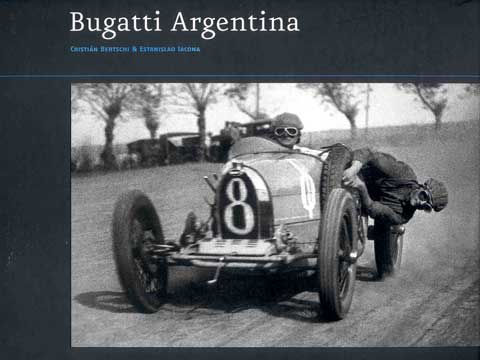
Bugatti Argentina by Estanislao Iacona and Cristian Bertschi
Review by Pete Vack, Editor, VeloceToday
12 inches x 9 3/4 inches, 247 pages, historical black and white photos. Price $175 USD includes shipping worldwide via DHL.
“Pur Sang,” Volume 47, No. 2, Spring 2007, offered a short review of the latest book from Whitlefly, concluding that “The book tells the captivating history of the Bugattis in Argentina with many wonderful photos and is a must for all Bugatti enthusiasts.” And indeed it is all that and more. Whitefly, it should be noted, is a publishing effort “created in 2004 by Estanislao (“Laoâ€) Iacona and Cristian Bertschi for the purpose of salvaging and safeguarding the history of the Argentine car activity.â€
A Body of Work
“Bugatti Argentina†must be considered as a small part of a much larger body of work created by Iacona and Bertschi. Standing alone, “Bugatti Argentina†at 247 pages only piques the interest for more information about the history of classic cars in Argentina. The Iacona/Bertschi team, however, is notably prolific and “Bugatti Argentina†is only one volume in what is currently a trilogy, which now includes “Alfa Romeo Argentina,” “Ferrari Argentina: Sports cars,” and will later be joined by “Maserati Argentina†and “Ferrari Argentina: Single Seaters.” With the publication of “Alfa Romeo Argentina,†a great void was filled as Iacona and Berstchi were able to help Alfa historians such as Simon Moore and collectors such as Fred Simeone to piece together the histories of many important pre-war Alfas. (Read VeloceToday’s two part review of “Alfa Romeo Argentinaâ€)
As the Iacona/Bertschi team found while researching Alfas, volumes had been written on the subject of Alfa Romeo but the significant history of the marque in Argentina had been overlooked. So it was with Bugatti, photos of which kept cropping up during the related research on Alfa. The team found that as with Alfa, “…all these works [on Bugatti] and the thousands of articles published in specialized magazines possess something in common: they do not contain any information, data or photography on Bugatti in Argentina.â€
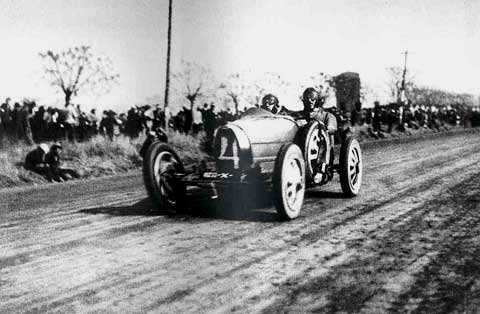 A T35 driven by Alberto Salcedo participates in the 1927 500 Millas Argentinas. Courtesy Guillermo S. Iacona.
A T35 driven by Alberto Salcedo participates in the 1927 500 Millas Argentinas. Courtesy Guillermo S. Iacona.
Yet they, too, were aware that the information may not be enough for a full length book. “This undertaking started with the idea of a small sized book, since we believed that there would be scant information available to be gathered, but the results proved contrary.â€
And so, to the contents. There is a chapter on the Bugatti family, concentrating on Carlo, Rembrandt, Ettore and Jean. The next chapter, “Argentine Mission in the U.S.A.,†give us an in-depth look at the five Bugattis entered in the 1923 Indianapolis 500. The next seven chapters deal with the information about Argentine Bugattis, the drivers, the races they entered, Roberto Mieres and his T51, and an unusual look at the twenty- three Bugattis purchased for the Buenos Aires Zoo. There is an index, a complete list of races in which Bugattis took part, a Bugatti Register with serial numbers for Argentina, and a look at some photos of “other†unidentified Bugattis the authors have found over the years. Another interesting chapter deals with the Argentine Bugatti search and rescue efforts that have been ongoing since the 1950s. Aside from the photos from the Bugatti Trust that illustrate the Bugatti family, almost all photos in the book are previously unpublished, and very much welcome.
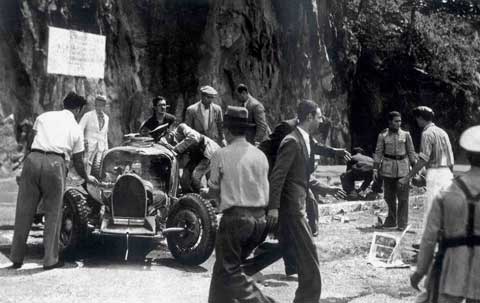 Cesare Milone’s T35B comes to grief during the Rio de Janeiro Grand Prix in 1934. Courtesy El Graphico.
Cesare Milone’s T35B comes to grief during the Rio de Janeiro Grand Prix in 1934. Courtesy El Graphico.
A Wider View
After the Forward, written by H.R. G. Conway, there is a section that somewhat unexpectedly is devoted to the world of art, architecture and culture in pre-WWII Argentina, written by Teresa Gonzales Bonorino de Iacona, who is Lao Iacona’s mother. Mrs. Iacona gives the reader a different view of Argentina in each volume, and for normally Eurocentric enthusiasts it is most welcome and provides much needed background to the Argentine story. “Alfa Romeo Argentina†included a history of the country from 1900 to 1972; “Bugatti Argentina†of art and architecture; in “Ferrari Argentina: Sports cars†(which we will review in an future edition of VeloceToday) Mrs. Iacona discusses the role of immigration to the country.
Bugatti at Indy
The authors write in-depth about the seemingly ill-fated journey to Indianapolis in 1923, a venture headed by Martin de Alzaga Unzué. The text was credited to a 1972 interview with Unzué in Corsa magazine, and the story also appeared in Bugatics, vol. 41 no. 3. Iacona and Bertschi follow that up with an interesting look at Unzué’s exciting life. The photos too, are rare and excellent, which give a remarkable view of the Bugattis at Indy. Not answered, however, is whether or not the coachbuilder, a man named Luis Béchereux, was actually responsible for the famous Bugatti horseshoe shaped grille, as suggested by Jonathan Wood (Bugatti: The Man and the Marque).
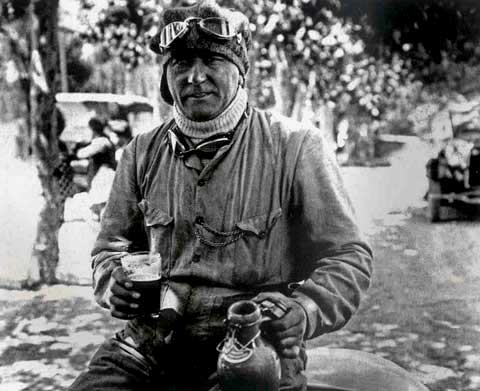 French born Jorge Perin takes a well earned break from racing a Bugati T35C. “Bugatti Argentina” captures the atmosphere of the times and provides driver bios. Courtesy Guillermo S. Iacona.
French born Jorge Perin takes a well earned break from racing a Bugati T35C. “Bugatti Argentina” captures the atmosphere of the times and provides driver bios. Courtesy Guillermo S. Iacona.
The authors estimate that there may have been as many as sixty Bugattis imported to Argentina in the 1920s through a variety of sources, including the official importer of Bugattis in Brazil, directly from France via one Aquillino Garcia, or Luis Tirasso in Buenos Aires.
Easier to trace were the Bugattis entered in Argentine events, in which the T35 and T37s did themselves proud in the hands of some of Argentina’s most famous drivers. Iacona and Bertschi tracked the events from 1926 to 1952 in which Bugattis were entered, including the overall position, driver, car number and car type. Sadly, most serial numbers were lost to the ages and of course not particularly important in those heady days.
Roberto Mieres
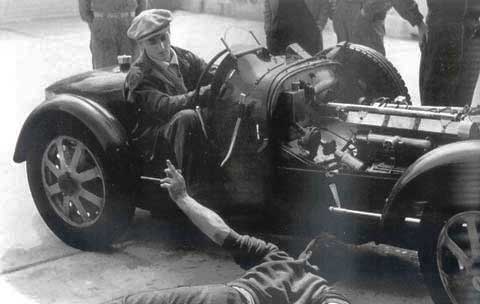 Roberto “Betito” Mieres sits in the ex-Varzi T51 shortly after its arrival in Buenos Aires. Courtesy Speratti Family.
Roberto “Betito” Mieres sits in the ex-Varzi T51 shortly after its arrival in Buenos Aires. Courtesy Speratti Family.
A young man with a drive to race imported one of the most famous Bugattis in history and made history himself with a T51 Grand Prix car once owned by Achille Varzi. Roberto Mieres, while in Italy in 1950, found himself in a conversation with the late Achille’s father, who mentioned that his son had an old Bugatti in storage. Mieres soon found himself to be the owner of a slightly used (and never raced!) T51 for only $1000. Mieres tells his story as if it were only yesterday, accompanied with many photos. (Roberto Mieres would later go on to drive Grand Prix Maseratis for the factory team in 1954 and 1955, his best finish being a second place at his home event, the Buenos Aires Grand Prix on January31 1954 with a A6SSG/250F.)
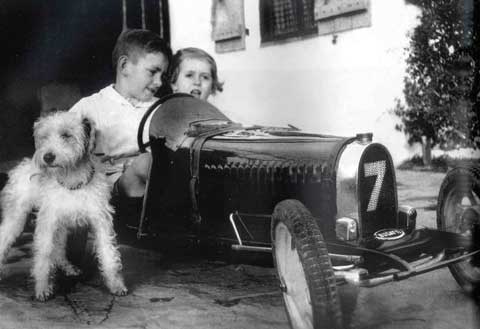 Eric Forrest Greene successfully campaigned a T35 in the 1930s; here his son and daughter enjoy their T52, with the same number as their father’s car. Courtesy Jackie Forrest Green.
Eric Forrest Greene successfully campaigned a T35 in the 1930s; here his son and daughter enjoy their T52, with the same number as their father’s car. Courtesy Jackie Forrest Green.
In 1964, Horacio R. Speratti wrote about the twenty-three Bugattis at the Buenos Aires Zoo, ordered in 1930 directly from Bugatti. The authors reprinted his article and updated it, including many photos of the astounding collection of miniature T52s that were rented and raced by very lucky Argentine children. It constitutes a truly fascinating chapter in the history of Bugatti in Argentina.
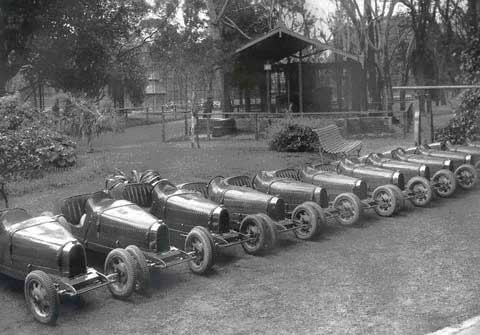 Less than half of the 23 T52s are seen here in this photo taken in 1930 at the Buenos Aires Zoo. Courtesy AGN.
Less than half of the 23 T52s are seen here in this photo taken in 1930 at the Buenos Aires Zoo. Courtesy AGN.
At $175 plus shipping via DHL (it can be ordered though the VeloceToday Store), “Bugatti Argentina†is not inexpensive, but a great service to Bugatti enthusiasts and anyone interested in Argentina.
Whitefly has announced that $75 can be saved if all three books are ordered at the same time; Alfa Romeo Argentina, Bugatti Argentina, Ferrari Argentina: Sports cars. Contact vack@cox.net for details.
Very intersting and nice book. Good research and lot of pictures, with many rare informations from this part of the world
hola soy de argentina tenes como puedo conseguir informacion de bugatti en argentina